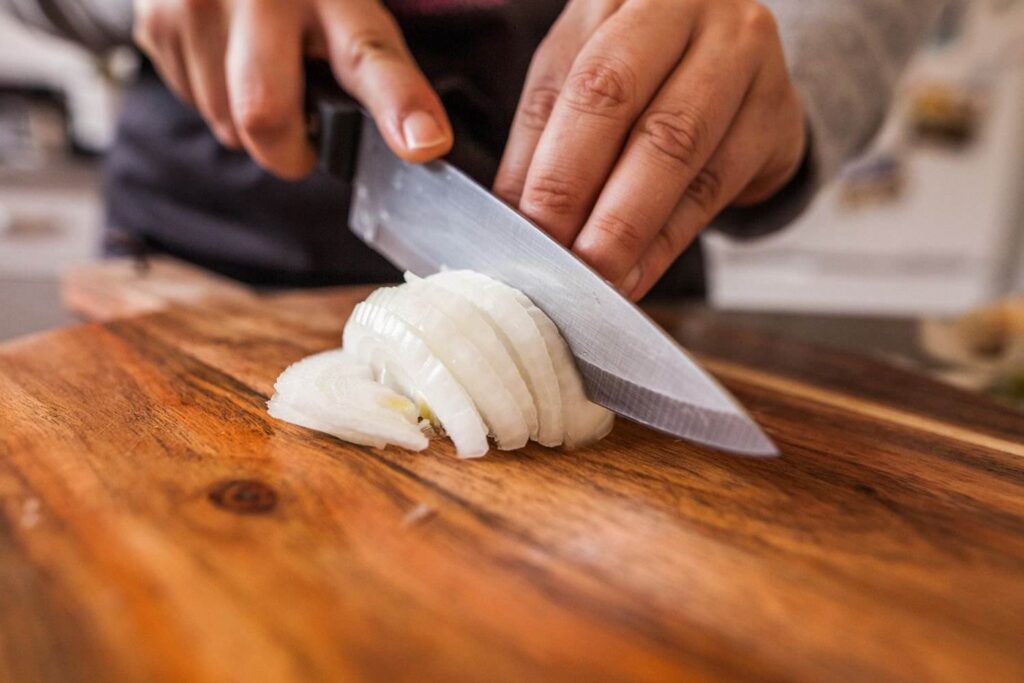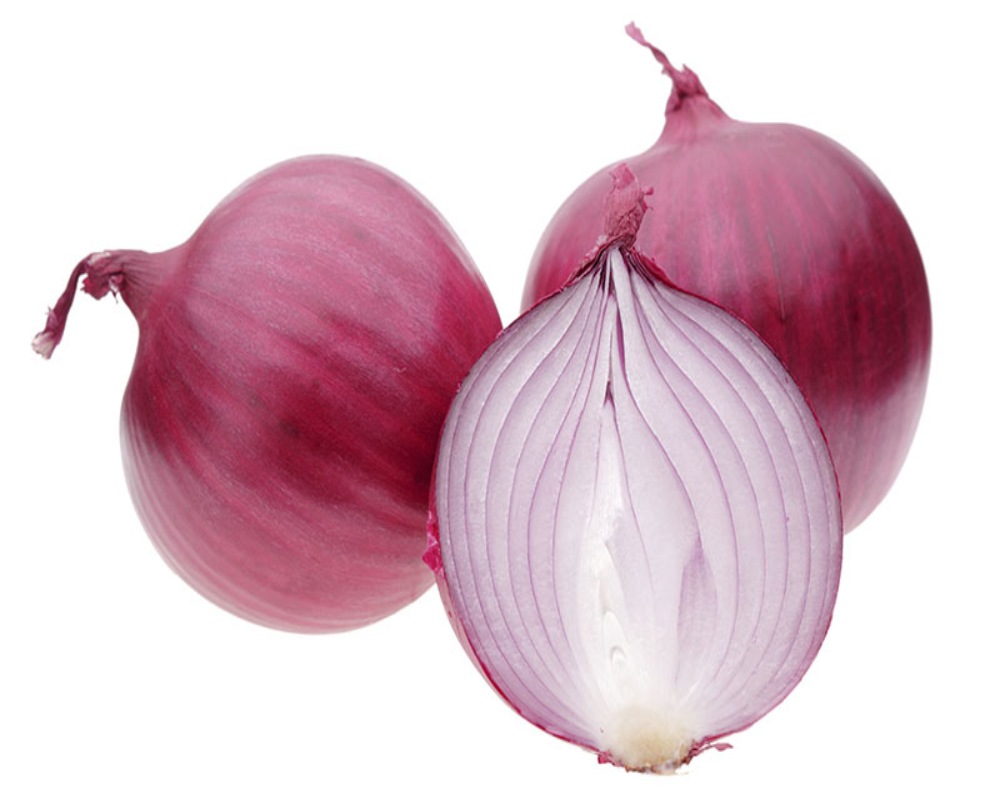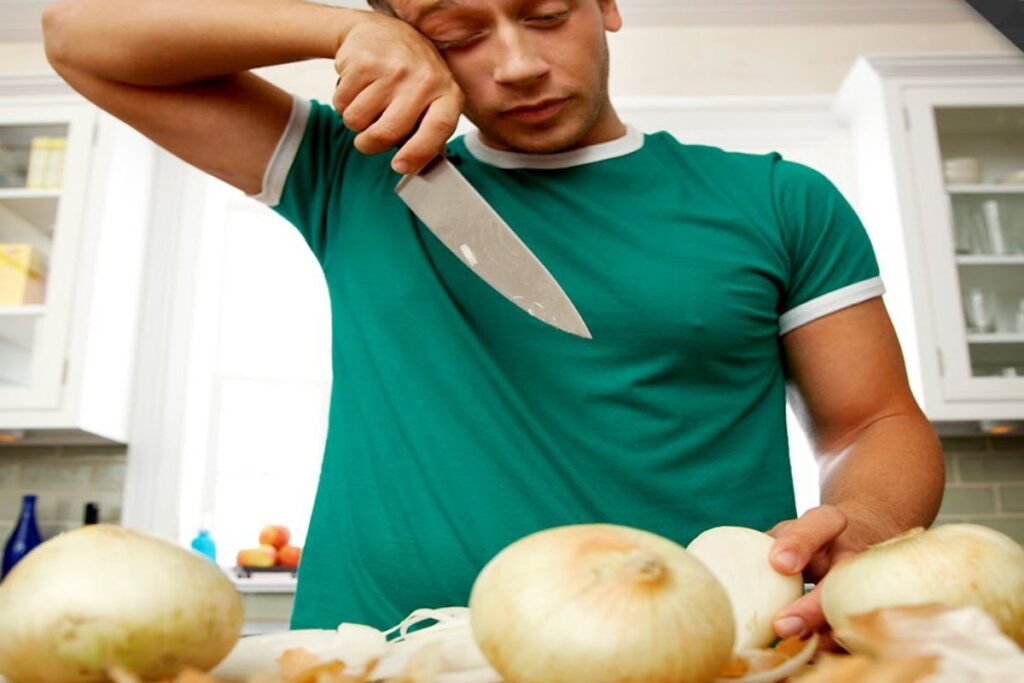Cutting onions is one cooking activity that many people do not look forward to. That’s because of the uncontrollable tears that usually follow. While there are some valid reasons to shed tears, cooking isn’t one of them.
But what if we tell you that there are ways to cut onions without watery eyes? Yes! You can. We’ve compiled a list of simple but effective hacks that will make cutting onions an enjoyable culinary venture. But first, let’s understand why cutting onions brings tears to one’s eyes.
Why Do Onions Make You Cry?
Is there a reason we cry when we cut onions? Yes, there is, and it has nothing to do with feelings of remorse or any type of emotion. It’s a result of certain reflex actions taken by your body to avoid damage. Let’s explain.
It’s no news that onions grow under the ground. There, they are exposed to attacks from animals like voles, who find great delight in feeding on bulbs, roots, and tubers. The only way for the onion bulbs to prevent being ravaged is by employing an interesting defense mechanism. Without this, they will never grow to maturity.
As soon as their fleshy skin is broken, onions release enzymes and sulphenic acid. Both substances produce an irritant gas known as Propanethial S-oxide. This gas transforms into sulfuric acid as soon as it touches the eyes. In defense, the eyes generate more tears to ward off the acid.
ALSO READ: What Are the Health Benefits of Tomatoes?
How to Stop Onions From Making You Cry
There are many ways to ensure you don’t cry while cutting onions. One of them is to sharpen your knife. Sharper knives have smaller surface areas at the cutting edge. Therefore, they inflict less damage on the onions, which in turn releases less gas. Although this method may not stop the tears, it will reduce them significantly.
Another clever hack to try involves refrigeration. Allow your onions to spend some time in the fridge before they get to the chopping board. The colder they are, the slower the chemical reactions that release the gases will be. All they need is to spend some time in the fridge, between 30 and 45 minutes,, and you are good to go.

Another way out is to protect your eyes with simple glasses or shades. No matter the volume of gas the onion releases, as long as your eyes are shielded, it will remain dry. Also, vegetable-cutting appliances will do you a lot of good. Some blenders have cutting and chopping blades that will do the job while the onion is enclosed. Also, go for fresher onions if you can. They emit less gas.
How Many Ways of Cutting Onions Are There?
There are three popular ways to cut an onion. You can slice, dice, or mince them.
Sliced onions appear round and flat. This is the preferred shape for salad or burger toppings, but some people use them as food ingredients. To slice an onion, first cut it in half. Then, placing one half on its flat side, support it with your fingers while the other hand runs the knife across. You can do the same for the other half.
Diced onions look like cubes. This is the popular onion shape for salsas, soups, home fries, and sauces. To achieve this, place a half onion on its flat side and make about three horizontal cuts. Holding the cuts in place, proceed to make vertical slices.
Minced onions are very small, finely chopped onions. All you need to do is first make diced onions. Afterward, start slicing all the diced onions into smaller sizes until satisfied.

Do You Soak Onions Before Cutting?
Soaking onions in cold water is one of the priceless hacks for preparing vegetables. Soaking onions aims is to soften the flavor and eliminate some of its pungency.
The popular question surrounding this cooking technique centers around the timing: “Do you soak onions before cutting?” The answer is no. It’s best to soak them after cutting for a quicker and more thorough job. Soak them for 5 to 10 minutes, then squeeze out the water before using.
ALSO READ: Tips on How To Use Turmeric Milk for Cholesterol Management
What Does Onion Symbolize?
Onions have a range of symbolism in many cultures across the globe. In most of these cultures, onion stands for prosperity and protection. In some cultures, onions are believed to chase evil spirits away.
They are also used in rituals on occasions such as funerals and weddings. They are used in funerals because of their concentric layering, which symbolizes eternity. In some other cultures, its multi-layer makeup represents how complicated human emotions can be.

What Is Slice Cutting?
If you want to know your onions around the kitchen, the art of slicing is a priceless skill to learn. That’s because many dishes require sliced onions to bring out their best. However, many other food items require the skill, such as other vegetables, cheese, and even bread.
Generally, slicing means cutting against the grain. When you slice a half-onion bulb, you get a round crescent-like shape. For leafy green vegetables, the technique of slicing them perpendicularly to achieve long, thin strands is called chiffonade.
Chiffonade is a French word meaning “made of rags” or “little ribbons.” It refers to the strands of vegetables which look like ribbons that result from it. Vegetables cut with the chiffonade technique include Sorrel, Swiss chard, and spinach.
You Might Also Like:
Morgan Stanley Executive Jonathan Bloomer and His Wife Missing After Luxury Yacht Sinks in Sicily
Joe Biden Passes the Torch to Kamala Harris With an Invigorating DNC Speech
Michael Oher Says He Didn’t Sue the Tuohys Because of Money: “I Worked Hard”
Quick Hacks for Fixing Your Broken Zipper
Microwave Popcorn Hacks: How to Make the Fluffiest, Tastiest Bites
